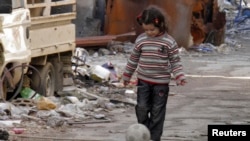UNITED NATIONS, NEW YORK —
The United Nations is welcoming reports the Syrian government and opposition have agreed to allow civilians to leave the old city of Homs, an area that has been cut off from humanitarian aid for more than a year.
Syria’s state-run news agency says the deal covers "innocent civilians" including women, children, the elderly and the injured. The agreement was also reported to include a plan to provide humanitarian assistance to civilians in the old city.
While the official media report said the deal was with the United Nations, language in a U.N. statement welcoming the news did not refer to the organization’s direct involvement.
U.N. humanitarian chief Valerie Amos welcomed word of the “humanitarian pause,” saying it would allow civilians to leave and for the delivery of essential aid for about 2,500 people.
U.N. spokesman Farhan Haq told reporters that a deal was necessary among the parties, which includes agreements with humanitarian workers.
“Right now we welcome the news that this agreement has been reached; what we are trying to do is see if it can be implemented on the ground," Haq said. "Valerie Amos has made clear she is monitoring the situation and we will see what progress we can make and whether aid can actually get to the people of Homs who have needed it for so long.”
The U.N. Security Council also is considering a possible resolution demanding better humanitarian access. Britain’s ambassador said it is still under discussion, but he expected it to be moving forward shortly. Russia’s envoy has said his government is against the idea.
U.S. Ambassador Samantha Power expressed concern about who would be allowed in and out of Homs.
“I note regime statements this morning describing a willingness to evacuate ‘innocents,’” said Power. Given that the regime, up to this point, has described just about anybody living in opposition territory as a terrorist and has attacked them as such, we have reason on the basis of history to be very skeptical and frankly very concerned about anybody who falls into regime hands who comes from a part of the country that has been under opposition control.”
Earlier, the Security Council held a private session to discuss the status of the elimination and destruction of Syria’s chemical weapons arsenal.
The coordinator for the project, Sigrid Kaag, told reporters afterwards that despite delays in meeting some intermediate deadlines, she thinks the June 30 overall deadline can be reached.
“All equipment and requirements are in-country, there is an expectation of swift movement, safe and secure, naturally noting the security conditions in-country that are volatile and precarious,” said Kaag.
Syria has made only two shipments of chemical weapons materials so far, removing only about 5 percent of its stockpile.
Kaag said the percentage of what is removed and destroyed continues to grow, as some destruction is taking place inside Syria. Kaag also noted that mustard gas comprises just 1.5 percent of Syria’s chemical weapons arsenal, but is the most harmful agent. She said once that is removed for onward destruction, it would mean a significant harmful agent is out of the country.
Syria’s state-run news agency says the deal covers "innocent civilians" including women, children, the elderly and the injured. The agreement was also reported to include a plan to provide humanitarian assistance to civilians in the old city.
While the official media report said the deal was with the United Nations, language in a U.N. statement welcoming the news did not refer to the organization’s direct involvement.
U.N. humanitarian chief Valerie Amos welcomed word of the “humanitarian pause,” saying it would allow civilians to leave and for the delivery of essential aid for about 2,500 people.
U.N. spokesman Farhan Haq told reporters that a deal was necessary among the parties, which includes agreements with humanitarian workers.
“Right now we welcome the news that this agreement has been reached; what we are trying to do is see if it can be implemented on the ground," Haq said. "Valerie Amos has made clear she is monitoring the situation and we will see what progress we can make and whether aid can actually get to the people of Homs who have needed it for so long.”
The U.N. Security Council also is considering a possible resolution demanding better humanitarian access. Britain’s ambassador said it is still under discussion, but he expected it to be moving forward shortly. Russia’s envoy has said his government is against the idea.
U.S. Ambassador Samantha Power expressed concern about who would be allowed in and out of Homs.
“I note regime statements this morning describing a willingness to evacuate ‘innocents,’” said Power. Given that the regime, up to this point, has described just about anybody living in opposition territory as a terrorist and has attacked them as such, we have reason on the basis of history to be very skeptical and frankly very concerned about anybody who falls into regime hands who comes from a part of the country that has been under opposition control.”
Earlier, the Security Council held a private session to discuss the status of the elimination and destruction of Syria’s chemical weapons arsenal.
The coordinator for the project, Sigrid Kaag, told reporters afterwards that despite delays in meeting some intermediate deadlines, she thinks the June 30 overall deadline can be reached.
“All equipment and requirements are in-country, there is an expectation of swift movement, safe and secure, naturally noting the security conditions in-country that are volatile and precarious,” said Kaag.
Syria has made only two shipments of chemical weapons materials so far, removing only about 5 percent of its stockpile.
Kaag said the percentage of what is removed and destroyed continues to grow, as some destruction is taking place inside Syria. Kaag also noted that mustard gas comprises just 1.5 percent of Syria’s chemical weapons arsenal, but is the most harmful agent. She said once that is removed for onward destruction, it would mean a significant harmful agent is out of the country.





